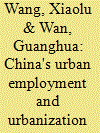| Srl | Item |
| 1 |
ID:
130972


|
|
|
|
|
| Publication |
2014.
|
| Summary/Abstract |
The present paper argues that China's existing population and employment statistics are misleading, and have failed to include many of the migrant and labor force flows between urban and rural areas. The paper reconciles the differences between official census data and other survey statistics and attempts to recalculate China's urban population and employment figures. Our analyses indicate that official statistics of 2012 underestimate China's urban employment by approximately 47 million while overestimating rural employment by 31 million. The adjusted urbanization rate exceeded 55 percent in 2012, almost 3 percentage points higher than the official statistics. Nevertheless, there remains much potential for rural-to-urban migration. More specifically, if the current bottlenecks in household registration, social security and public welfare systems can be removed or relaxed, China's urbanization rate could rise by another 10 percentage points or even more over the next decade.
|
|
|
|
|
|
|
|
|
|
|
|
|
|
|
|
| 2 |
ID:
124560


|
|
|
|
|
| Publication |
2013.
|
| Summary/Abstract |
This paper tests whether body size affects employment status in the Chinese urban labor market. Based on Urban Resident Basic Medical Insurance (URBMI) survey data, we find that body size has an inverted U-shaped effect on the probability of being employed when human capital and other factors are controlled, indicating the existence of "body size discrimination". Based on our results, the optimal BMI for employment is estimated to be 22.7 for female and 24.3 for male. Further studies show that the "health channel" and the "esthetic channel" play an important role in forming the body size discrimination among both male and female. Furthermore, we find that the employment type (formal employment vs. informal employment) is also affected by body size. Our paper provides new evidence on the impact of body size on employment, and reveals new characteristics of the Chinese urban labor market.
|
|
|
|
|
|
|
|
|
|
|
|
|
|
|
|